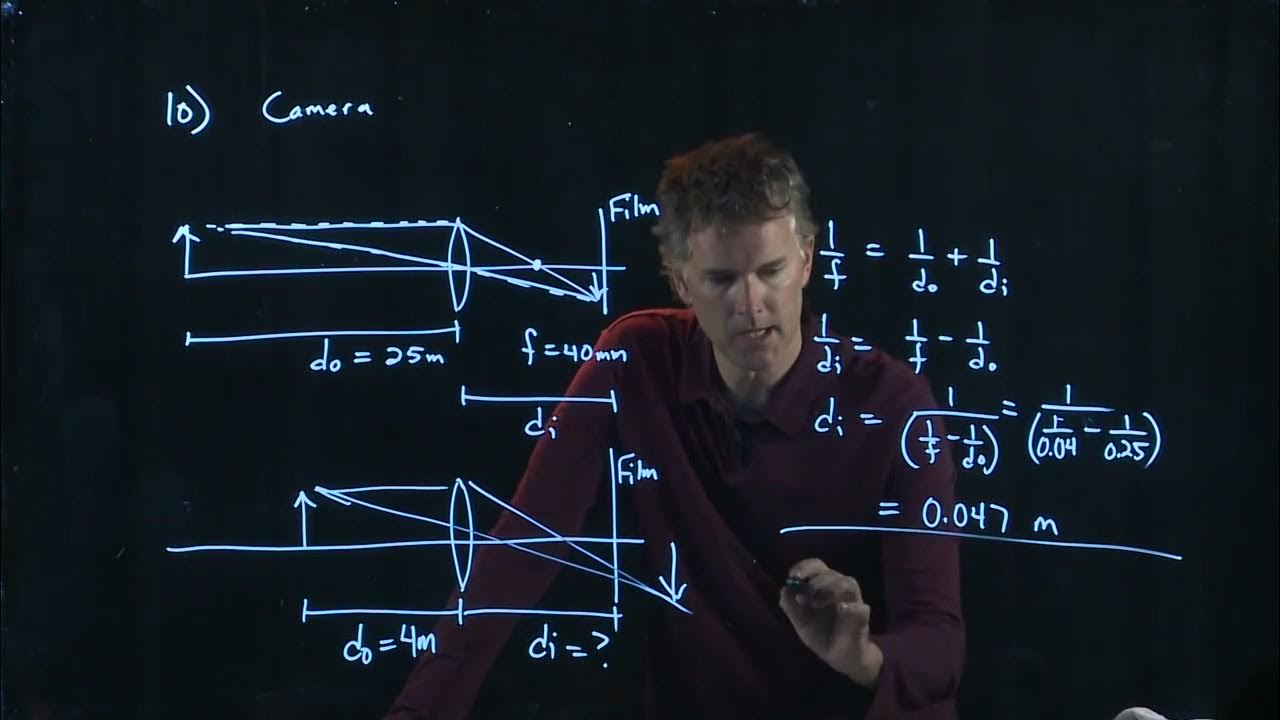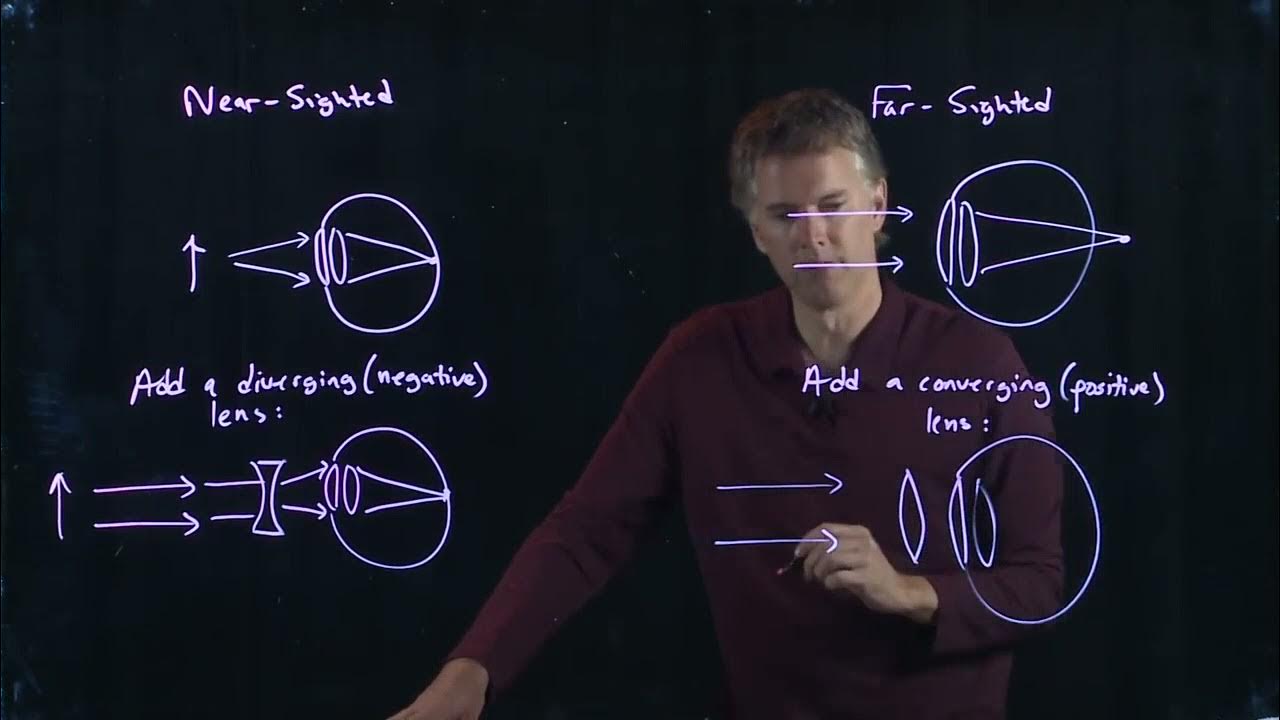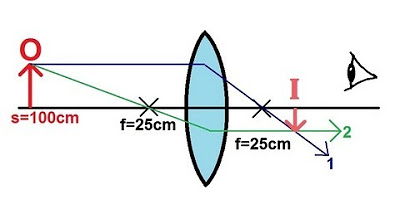Adjusting Camera Focus | Physics with Professor Matt Anderson | M28-04
TLDRThis educational script explains the concept of maintaining focus on a moving subject, using the analogy of a camera to an eyeball. It illustrates how when a dog, initially in focus, moves away, the photographer must adjust the lens position to keep the subject sharp. The explanation involves the movement of the lens closer to the film or sensor to compensate for the subject's increased distance, ensuring the image remains in focus, with a clear example of how parallel rays of light are manipulated to achieve this.
Takeaways
- 📷 The camera is compared to an eyeball, with the lens and film plane analogous to the cornea and retina respectively.
- 🐕 When photographing a dog, if it moves away, the focus needs to be adjusted to keep the image sharp.
- 🔍 Focal points are critical in determining where the rays of light converge to form a clear image on the film or sensor.
- 🌟 Rays of light coming off the dog, when it's close, converge at certain focal points to be in focus on the film plane.
- 🏞 As the dog moves further away, the position of the image relative to the film plane changes, requiring lens adjustment.
- 🔧 To keep the moving dog in focus, the lens should be moved closer to the film or sensor plane.
- 🔄 The film plane is fixed and cannot be moved, but the position of the lens can be adjusted to maintain focus.
- 📐 Parallel rays of light passing through the focus point will converge and form an image that is in focus on the film plane.
- 🔄 When the subject moves further away, the lens must be moved closer to the film plane to correct the image position.
- ∞ At infinity, the focal point should align with the film plane for a sharp image, assuming an ideal lens.
- 📚 Understanding the relationship between the subject's distance, lens position, and focus is essential for photography.
Q & A
What is the analogy used in the script to explain the camera's function?
-The script uses the analogy of an eyeball to explain the camera's function, with the lens being like the cornea and the film or CCD plane being like the retina.
Why does the dog need to be kept in focus when it moves away?
-The dog needs to be kept in focus to ensure that the photograph is sharp and clear, capturing the subject accurately as it moves.
What happens to the focal points when the subject moves away from the camera?
-When the subject moves away, the focal points shift, and the rays that would have been focused on the film plane now miss it, resulting in a blurred image.
How does the script describe the relationship between the subject's distance and the lens position?
-The script explains that as the subject moves further away, the lens should be moved closer to the film plane to maintain focus.
What is the role of the film plane or CCD plane in this scenario?
-The film plane or CCD plane is where the image is formed. It is fixed and cannot be moved, so adjustments are made with the lens to keep the image in focus.
What adjustment is made to the lens to keep a moving subject in focus?
-To keep a moving subject in focus, the lens is moved closer to the sensor or film plane as the subject moves further away.
What does the script suggest about the position of the focal point when photographing a distant subject?
-The script suggests that when photographing a subject at infinity, the focal point should be at the film plane to achieve focus.
How does the script illustrate the concept of focus using rays of light?
-The script uses rays of light to illustrate focus by showing how parallel rays passing through the lens focus on the film plane, ensuring a sharp image.
What is the significance of the lens moving to the right in the script's explanation?
-The significance of the lens moving to the right is that it adjusts the position of the image on the film plane, compensating for the subject's movement and maintaining focus.
What does the script imply about the mechanics of a camera when a subject moves?
-The script implies that the mechanics of a camera involve adjusting the lens position relative to the film or sensor plane to accommodate changes in the subject's distance.
How does the script use the concept of infinity in the context of focus?
-The script uses the concept of infinity to describe a situation where the subject is very far away, and the focal point should align with the film plane to achieve focus.
Outlines
📷 Adjusting Focus for Moving Subjects
This paragraph explains the concept of maintaining focus on a moving subject, specifically a dog, in photography. It starts by likening the camera to an eyeball, highlighting the lens and film plane as key components. The script discusses how to keep the dog in focus as it moves away from the camera. It uses the analogy of light rays and focal points to illustrate the process. The key takeaway is that when the subject moves further away, the lens should be moved closer to the film or sensor to keep the image in focus. This is a fundamental principle in photography for capturing sharp images of moving subjects.
Mindmap
Keywords
💡Camera
💡Focus
💡Lens
💡Film Plane
💡CCD Plane
💡Retina
💡Focal Point
💡Parallel Rays
💡Image
💡Sensor
💡Infinity
Highlights
The camera is compared to an eyeball, with the lens and film plane analogous to the cornea and retina.
The concept of focusing on a dog and the importance of adjusting focus as it moves away is introduced.
A visual explanation of how rays of light focus through the camera lens to the film plane is provided.
The illustration of how parallel rays focus through the camera's focal point to maintain a sharp image.
The necessity of adjusting the lens position when the subject moves further away to keep it in focus.
A step-by-step guide on how to adjust the lens to maintain focus as the subject moves.
The explanation of moving the lens closer to the film or sensor when the subject moves away.
The analogy of the film plane being fixed, similar to the fixed position of the retina in the eye.
The importance of lens movement to adjust the image position on the fixed film plane.
The concept that when the subject is at infinity, the focal point should align with the film plane.
The practical application of adjusting the lens for different distances to achieve a focused image.
The use of visual aids like drawing focal points to understand the focusing mechanism.
The explanation of how the direction of lens movement affects the position of the image.
The clarification that moving the lens to the right will move the image to the right on the film plane.
The instruction to move the lens closer to the sensor or film for distant subjects.
The confirmation that moving the lens closer to the film is the correct action when the subject moves away.
The summary of the principles behind adjusting focus in photography as the subject's distance changes.
Transcripts
Browse More Related Video

The Camera | Physics with Professor Matt Anderson | M28-20

Near Sighted vs Far Sighted | Physics with Professor Matt Anderson | M28-02

Physics - Optics: Lenses (1 of 4) Converging Lens

The Magnifying Glass | Physics with Professor Matt Anderson | M28-10

Human Eye - The Dr. Binocs Show | Best Learning Videos For Kids | Peekaboo Kidz

Optical Instruments - Your Eyeballs | Physics with Professor Matt Anderson | M28-01
5.0 / 5 (0 votes)
Thanks for rating: